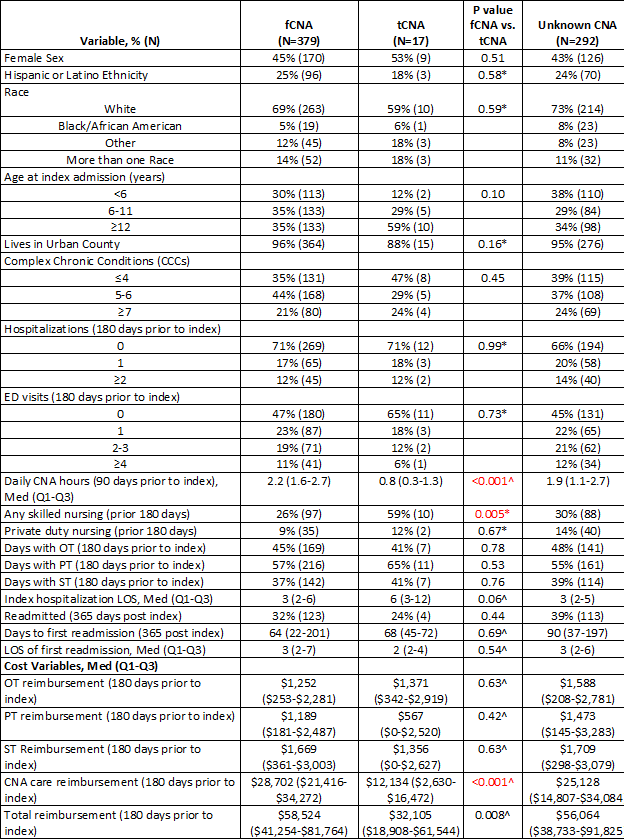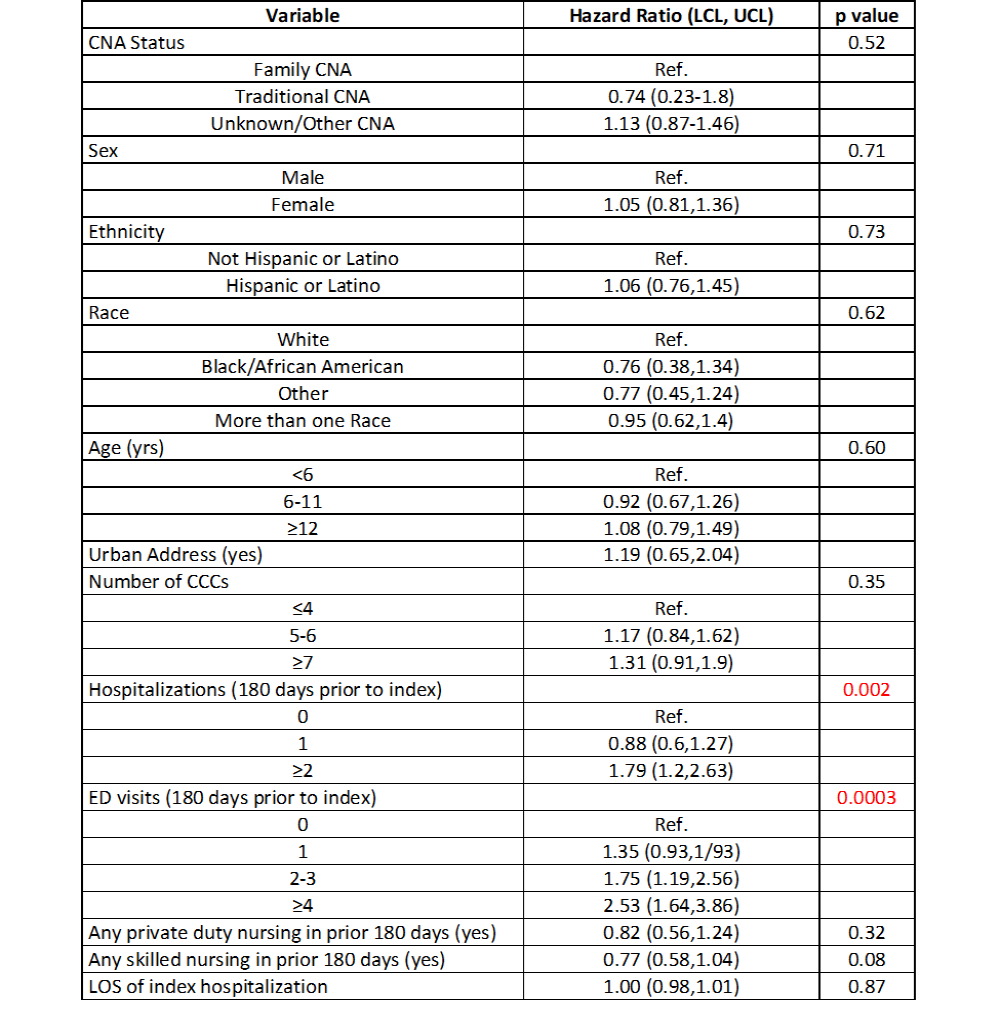Children with Chronic Conditions
Category: Abstract Submission
Children with Chronic Conditions III
594 - Cost and Utilization Outcomes of Paid Family Caregiving for Medically Complex Children
Monday, April 25, 2022
3:30 PM - 6:00 PM US MT
Poster Number: 594
Mark Brittan, Children's Hospital Colorado, Aurora, CO, United States; Brenda Beaty, University of Colorado, Aurora, CO, United States; Krithika Suresh, Colorado School of Public Health, Denver, CO, United States
- MB
Mark Brittan, MD, MPH
Associate Professor
University of Colorado
Aurora, Colorado, United States
Presenting Author(s)
Background: Despite its popularity with families, the economic impact of Colorado’s paid family Certified Nursing Assistant (fCNA) program for children with medical complexity (CMC) remains unknown.
Objective: In this study, we compared patient characteristics, health care utilization, and costs of hospitalized CMC who receive traditional CNA (i.e., CNA care provided by a non-family member; tCNA) versus family-provided CNA care (fCNA).
Design/Methods: Retrospective cohort analysis using linked hospital data with the Colorado all payer claims database. Among CMC with a hospitalization between 2012-2018, we compared measures of health service use, health care utilization, and costs between those with fCNA vs. tCNA care. We used multivariable Cox Proportional Hazards (CPH) to examine risk factors for two separate outcomes: 1) time to hospital readmission and 2) time to ED revisit within one year of index admission. The primary predictor was fCNA vs tCNA status. Covariates included demographics, complex chronic conditions (CCCs), health service utilization in the 6 months prior to index admission, and index hospital length of stay.
Results: We identified 760 children with index hospitalizations, and 498 with discernable CNA status (fCNA, n=379; tCNA, n=17; unknown, n=262). Comparing fCNA and tCNA patients, we found no statistically significant differences in demographics, CCCs, and most health utilization indicators. Family CNA patients had more days of contiguous CNA care, more daily hours of CNA care, and more reimbursed CNA care, but proportionately less skilled nursing care than tCNA patients in the 90 days prior to index admission (Table 1). Adjusted for patient demographics and measures of medical complexity, CNA status (tCNA vs. fCNA) was not predictive of 365-day readmissions (HR: 0.74, 0.23-1.8; p=0.5) or ED revisits (HR: 0.91, 0.43-1.71; p=0.8) (Tables 2,3). Increasing numbers of hospitalizations and ED visits in the 180 days prior to index admission were associated with greater risk of 365-day readmission , whereas increasing number of ED visits only was associated with greater risk of 365-day ED reutilization.Conclusion(s): Due to low numbers of tCNA patients, we were underpowered to detect clinically meaningful utilization and cost differences between fCNA and tCNA patients. Preliminarily, fCNA patients receive more CNA care and less skilled nursing care, without statistically significant differences in risk of 365-day hospital or ED reutilization than tCNA patients
Table 1 Comparison of fCNA and tCNA patient characteristics Key
Key
* Fisher's Exact Test
^ Wilcoxon Test
fCNA (family CNA); tCNA (traditional CNA); OT (occupational therapy); PT (physical therapy); ST (speech therapy)
Table 2 Association of Risk Factors with 365-day Readmission from Adjusted Cox Proportional Hazards Analysis
Objective: In this study, we compared patient characteristics, health care utilization, and costs of hospitalized CMC who receive traditional CNA (i.e., CNA care provided by a non-family member; tCNA) versus family-provided CNA care (fCNA).
Design/Methods: Retrospective cohort analysis using linked hospital data with the Colorado all payer claims database. Among CMC with a hospitalization between 2012-2018, we compared measures of health service use, health care utilization, and costs between those with fCNA vs. tCNA care. We used multivariable Cox Proportional Hazards (CPH) to examine risk factors for two separate outcomes: 1) time to hospital readmission and 2) time to ED revisit within one year of index admission. The primary predictor was fCNA vs tCNA status. Covariates included demographics, complex chronic conditions (CCCs), health service utilization in the 6 months prior to index admission, and index hospital length of stay.
Results: We identified 760 children with index hospitalizations, and 498 with discernable CNA status (fCNA, n=379; tCNA, n=17; unknown, n=262). Comparing fCNA and tCNA patients, we found no statistically significant differences in demographics, CCCs, and most health utilization indicators. Family CNA patients had more days of contiguous CNA care, more daily hours of CNA care, and more reimbursed CNA care, but proportionately less skilled nursing care than tCNA patients in the 90 days prior to index admission (Table 1). Adjusted for patient demographics and measures of medical complexity, CNA status (tCNA vs. fCNA) was not predictive of 365-day readmissions (HR: 0.74, 0.23-1.8; p=0.5) or ED revisits (HR: 0.91, 0.43-1.71; p=0.8) (Tables 2,3). Increasing numbers of hospitalizations and ED visits in the 180 days prior to index admission were associated with greater risk of 365-day readmission , whereas increasing number of ED visits only was associated with greater risk of 365-day ED reutilization.Conclusion(s): Due to low numbers of tCNA patients, we were underpowered to detect clinically meaningful utilization and cost differences between fCNA and tCNA patients. Preliminarily, fCNA patients receive more CNA care and less skilled nursing care, without statistically significant differences in risk of 365-day hospital or ED reutilization than tCNA patients
Table 1 Comparison of fCNA and tCNA patient characteristics
 Key
Key* Fisher's Exact Test
^ Wilcoxon Test
fCNA (family CNA); tCNA (traditional CNA); OT (occupational therapy); PT (physical therapy); ST (speech therapy)
Table 2 Association of Risk Factors with 365-day Readmission from Adjusted Cox Proportional Hazards Analysis

